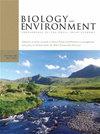Diversity and Specificity in Cyanobacterial Symbioses
IF 0.6
4区 环境科学与生态学
Q4 ENVIRONMENTAL SCIENCES
Biology and Environment-Proceedings of the Royal Irish Academy
Pub Date : 2022-01-01
DOI:10.3318/BIOE.2002.102.1.53
引用次数: 17
Abstract
Cyanobacteria constitute one of the largest sub groups of Gram-negative photosynthetic prokary otes and are of great evolutionary antiquity, dating back to the Precambrian (2.8-3.5 billion years ago). They are found worldwide in highly diverse ecosystems, from aquatic (limnic and marine) habi tats to terrestrial systems and from polar to tropical regions of the globe. In terrestrial systems, nitro gen-fixing Nostoc is by far the most common genus and includes cyanobacteria capable of forming symbioses with a broad range of plants and other organisms. Hosts include fungi (Geosiphon species and lichenised fungi), bryophytes (liverworts and hornworts), aquatic ferns (genus Azolla), gym nosperms (cycads) and angiosperms (genus Gunnera) (Bergman et al. 1996).蓝藻共生的多样性和特异性
蓝藻是革兰氏阴性光合作用生物中最大的亚群之一,具有悠久的进化历史,可追溯到前寒武纪(28 - 35亿年前)。它们分布在世界各地高度多样化的生态系统中,从水生(湖泊和海洋)栖息地到陆地系统,从极地到热带地区。在陆生系统中,固氮Nostoc是迄今为止最常见的属,包括能够与广泛的植物和其他生物形成共生的蓝藻。寄主包括真菌(地虹吸类和地衣真菌)、苔藓植物(苔类和角苔类)、水生蕨类(杜鹃花属)、植物裸子植物(苏铁)和被子植物(Gunnera属)(Bergman et al. 1996)。
本文章由计算机程序翻译,如有差异,请以英文原文为准。
求助全文
约1分钟内获得全文
求助全文
来源期刊
CiteScore
1.10
自引率
0.00%
发文量
6
审稿时长
>36 weeks
期刊介绍:
The journal aims to offer a broad coverage of the subject area, including the following:
- biology and ecology of the Irish flora and fauna
- microbial ecology
- animal, plant and environmental physiology
- global change
- palaeoecology and palaeoclimatology
- population biology; conservation of genetic resources
- pollution and environmental quality; ecotoxicology
- environmental management
- hydrology
- land use, agriculture, soils and environment.
Submissions on other relevant topics are also welcome, and papers of a cross-disciplinary nature are particularly encouraged.

 求助内容:
求助内容: 应助结果提醒方式:
应助结果提醒方式:


